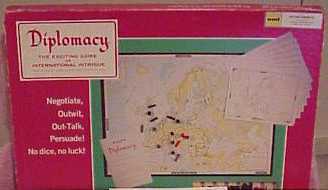The Editions
Allan B. Calhamer
1959. I've occasionally seen 1958 cited as the date commercially was first commercially sold. While it is true that there was a "1958 version" of Diplomacy, whose map and rules were somewhat different from what people play today, that version only existed as a prototype and was never sold (see this article by ABC himself for more information). The first commercial version (the 1959 version) had the same map as is used today, and substantially the same rules although there have been a number of revisions of the rulebook over the years.
Depends. If you are United-States-centric, cardboard has never been used. If you are talking worldwide, the answer is "none of the above," as the editions of Diplomacy published in Brazil used cardboard counters for armies and fleets.
I don't know. But if you said 1982, you're probably wrong. Most people associate plastic pieces with the Avalon Hill's second edition of Diplomacy, which had a revised rulebook and was released in 1982. However, there was an edition of Diplomacy sold prior to the second edition, which had the 1976 first edition rules and plastic pieces. Unfortunately, since both the box and rulebook are copyright 1976, I'm not sure when it was actually sold. If anyone knows anything more specific about dates, please let me know.

Did you say Games Research, Inc. or Avalon Hill?
Trick question... the answer is both. After well over a decade of selling Diplomacy in a dull brown box, Games Research finally redesigned the box sometime after 1974 (I don't actually know when). The box is marked with Games Research's name. When Avalon Hill acquired the rights to Diplomacy from Games Research in 1976, they either continued to make this version or, more likely, they inherited some unsold inventory of this edition which they continued to sell until they ran out. Although the box and gameboard are the same, you can tell the two editions apart by the rulebook since Avalon Hill included a rulebook with their name on it... the same one they continued to use when they published their bookcase edition.
The Companies
I know of ten: Australia, Brazil, Canada, France, Germany, Israel, Italy, Netherlands, U.K., U.S.A. If you know of any that are missing from this list, please let me know.
Philmar, Ltd.
Intellectual Diversions, Ltd., a company in the U.K.
Waddington's House of Games, a Canadian company.
Parker, which I believe was/is the European subsidiary of the U.S. company Parker Brothers, published both French and German editions of Diplomacy.
GROW Produtos Para Recreacao, Ltda., a Brazilian company, sold Diplomacy in Brazil reportedly without having licensed the rights to the game from Avalon Hill.
Diplomacy Around the World
1963, by Intellectual Diversions, Ltd.
Canadian editions of Diplomacy have a bilingual rulebook that includes rules in both English and French.
In the U.K., Diplomacy was sold by Intellectual Diversions, Ltd., by Philmar, Ltd., and by Gibson's Games. In Italy, Diplomacy was sold by Ariel, Mondadori Giochi, and by L'Editrice Giochi.
The Variants
Note: In this context, "variants" refers to commercially published and sold games (other than Diplomacy) that are designed around the same core mechanics of Diplomacy. In other words, this includes variants whose rules are identical to those of Diplomacy, as well as those games which may have many substantially new concepts but whose underlying mechanics are built upon those of Diplomacy.
I know of six: Ard-Ri, Classical Diplomacy, Colonial Diplomacy, Hundred, Kamakura, Machiavelli. Most Diplomacy players know of Machiavelli and Colonial Diplomacy. Classical and Hundred are popular in the PBEM community and many PBEM players have heard of them. Ard-Ri, though less known, also came out of the PBEM community and may be familiar to some people. Kamakura is definitely among the least (if not the least) well known of these games.
Machiavelli and Colonial Diplomacy were both republished with gameboards that had a revised map.
Only Machiavelli was republished in a box that differed from the original one. The box for the "revised" Colonial Diplomacy was identical to the original one.


